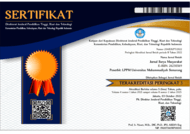Edukasi Bahaya Timbal pada Sekolah Rentan Polusi terhadap Prestasi Akademik dan Kesehatan Siswa
(1)
(2) Sekolah Tinggi ilmu Kesehatan Nasional
(3)
(*) Corresponding Author
Abstract
This community service project is a promotive and preventive activity that aims to educate students about the danger of lead exposure accumulation in students, delivered to teaching staff throughout Central Java. This activity was conducted as counseling using the webinar method through zoom meetings. Participants were enthusiastic, as seen from the questions asked during the discussion and question-answer sessions. The ability of participants to answer pretest and posttest questions showed an increase in participants’ knowledge between before and after the counseling. The average score of the pretest was 7.00 with a standard deviation of 3.428, while the average score of the posttest was 14.06 with a standard deviation of 1.983. A paired t-test was then used to determine whether the scores from the pretest and posttest differed. Given that the p-value for the difference between the pretest and posttest scores was 0.000, it can be said that the difference is statistically significant. It can be determined that the partner satisfaction questionnaire's answers were valid because they ranged from 0.549 to 0.905 when it was previously assessed for validity using the Pearson product-moment method. The instrument passed the reliability test with a Cronbach Alpha rating of 0.925, indicating that it was trustworthy. According to the results of the partner satisfaction survey, the typical score was 4.09. Thus, it can be concluded that the activity satisfies the participants. Based on the results of data analysis, it can be said that the counseling activities can increase participants’ knowledge about the danger of lead exposure accumulation on students’ achievement.
Full Text:
PDFReferences
Bellinger DC. (2004). Lead. Pediatrics 113: 1016–1022.
Brent JA. (2006). Review of: “Medical Toxicology”. Clin Toxicol 44: 355–355.
Bressler J, Kim KA, Chakraborti T, Goldstein G. (1999). Molecular mechanisms of lead neurotoxicity. Neurochem Res 24: 595–600.
Clevel and LM, Minter ML, Cobb KA, Scott AA, German VF. (2008). Lead hazards for pregnant women and children: Part 1: immigrants and the poor shoulder most of the burden of lead exposure in this country. Part 1 of a two-part article details how exposure happens, whom it aff ects, and the harm it can do. Am J Nurs 108: 40–49; quiz 50.
Cory-Slechta DA. (1996). Legacy of lead exposure: consequences for the central nervous system. Otolaryngol Head Neck Surg 114: 224–226.
Flora SJS, Flora G, Saxena G. (2006). Environmental occurrence, health eff ects and management of lead poisoning. (In: Jose, S. C, Jose, S., eds. Lead. Amsterdam: Elsevier Science B.V.). pp. 158–228.
Garza A, Vega R, Soto E. (2006). Cellular mechanisms of lead neurotoxicity.Med Sci Monit 12: RA57–65.
Kalia K, Flora SJ. (2005). Strategies for safe and eff ective therapeutic measures for chronic arsenic and lead poisoning. J Occup Health 47: 1–21.
Kriswedhani, G.A.P.(2015). Lead Poisoning in Children. J Majority, vol.4, no.2, hal.18-24.
Lanphear et.al. (2005). Low-Level Environmental Lead Exposure and Children’s Intellectual Function: An International Pooled Analysis, Environmental Health Perspectives,113: p. 894-9.
Lidsky TI, Schneider JS. (2003). Lead neurotoxicity in children: basic mechanisms and clinical correlates. Brain 126: 5–19.
Needleman, H. (2004). Lead Poisoning. Annual Reviews Med, 55:209-222, doi: 10.1146/annurev.med.55.091902.103653
Pearce JM. (2007). Burton’s line in lead poisoning. European neurology 57:118–9
Sanders T, Liu Y, Buchner V, Tchounwou PB. (2009). Neurotoxic eff ects and biomarkers of lead exposure: A Review. Res Environ Health 24: 15–45.
Shiek, et. al. (2010). Measurement Of Blood Lead Levels Among Medical Students In Faculty Of Medicine Taibah University And Their Effects On Intelligent Quotients And Study Performance Rates. International Journal Of Academic Research (Online), (www.mdpi.com/journal/ijerph).
WHO. (2010).Exposure to lead: A major public health concern. preventing disease through healthy environments. Public health and environment. Diakses dari: http://www.who.int/ipcs/features/lead.pdf.
Wright, J.P, et al. (2008). Association of Prenatal and Childhood Blood Lead Concentrations with Criminal Arrests in Early Adulthood. PLoS Medicine, vol 5, issue 5, page 732-740
Article Metrics
Abstract view : 267 timesPDF - 92 times
DOI: https://doi.org/10.26714/jsm.5.2.2023.201-207
Refbacks
- There are currently no refbacks.
Copyright (c) 2023 Jurnal Surya Masyarakat

Jurnal Surya Masyarakat (JSM) is licensed under Creative Commons Attribution-NonCommercial-NoDerivatives 4.0
------------------------------------------------------------------------------------------------------------------------
Jurnal Surya Masyarakat (JSM)
p-ISSN: 2623-0364; e-ISSN: 2623-0569
Published by: Lembaga Penelitian dan Pengabdian Masyarakat (LPPM) Universitas Muhammadiyah Semarang



.jpg)







.jpg)